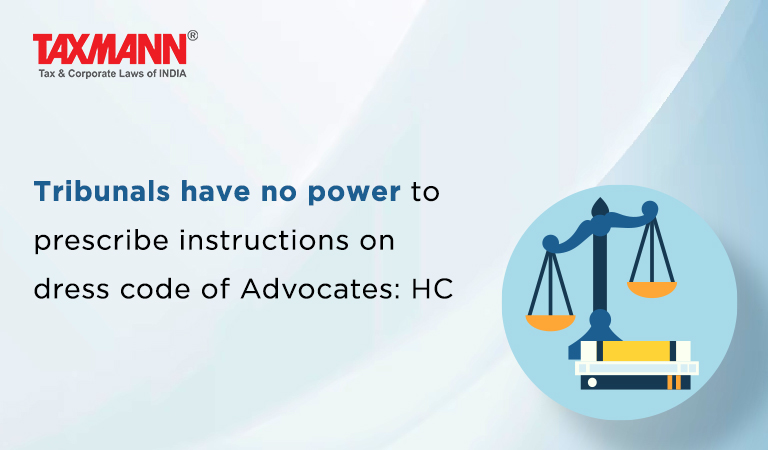Tribunals have no power to prescribe instructions on dress code of Advocates: HC
- Blog|News|Company Law|
- 2 Min Read
- By Taxmann
- |
- Last Updated on 13 February, 2023

Case Details: R. Rajesh v. Union of India - [2023] 147 taxmann.com 149 (HC-Madras)
Judiciary and Counsel Details
-
- R. Mahadevan & Mohammed Shaffiq, JJ.
- Rajesh for the Appellant.
- Dr.V. Venkatesan & S.R. Raghunathan for the Respondent.
Facts of the Case
In the instant case, the petitioner was an advocate practising in Courts and Tribunals at Chennai, including the NCLT. He was also a member of the Institute of Company Secretaries of India (ICSI). He filed a Public Interest Litigation for a writ of declaration to declare the order dated 14.11.2017 passed by the NCLT, insofar as it related to the imposition of dress code for advocates for appearance before the Tribunal as ultra vires, null and void.
Now, the question placed before the High Court was whether the statute has conferred powers on the Court with respect to the prescription of dress code.
It was observed that the statute has itself conferred powers on the High Court with reference to the prescription of dress code, hence, any instruction, direction, or advisory by the Tribunal, especially when it runs contrary to statutory rules, is ultra vires Act, and without there being any source of power for the issuance of such directions.
Further, on the conjoint reading of section 34 of the Advocates Act, 1961 read with Bar Council of India Rules, it was clear that only the High Courts can frame rules for dress code for the appearance of Advocates before it, Courts and Tribunals, subordinate to it.
Section 34 of the Advocates Act, 1961, read as follows –
Section 34: Power of High Courts to make rules:
(1) The High Court may make rules laying down the conditions subject to which an advocate shall be permitted to practise in the High Court and the courts subordinate thereto.
Also, the powers prescribed under rule 51 of the NCLT Rules, 2016 are merely for discharging functions as per Act, in accordance with the principles of natural justice and equity. Hence, the same cannot be said to confer power to prescribe dress code, more so when it is contrary to Bar Council of India Rules.
Rule 51 of the NCLT Rules, 2016 read as follows –
“51. Power to regulate the procedure:
The Tribunal may regulate its own procedure in accordance with the rules of natural justice and equity, for the purpose of discharging its functions under the Act.”
High Court Held
The High Court held that wearing of a gown is only optional and not mandatory before any courts other than the Supreme Court or High Courts. Therefore, the notification issued by the Registrar of NCLT making it mandatory for advocates appearing before its bench to wear gowns was to be quashed and set aside.
In view of the above, the High Courts can frame rules for dress codes for the appearance of advocates before the Courts and Tribunals subordinate to it.
Disclaimer: The content/information published on the website is only for general information of the user and shall not be construed as legal advice. While the Taxmann has exercised reasonable efforts to ensure the veracity of information/content published, Taxmann shall be under no liability in any manner whatsoever for incorrect information, if any.

Taxmann Publications has a dedicated in-house Research & Editorial Team. This team consists of a team of Chartered Accountants, Company Secretaries, and Lawyers. This team works under the guidance and supervision of editor-in-chief Mr Rakesh Bhargava.
The Research and Editorial Team is responsible for developing reliable and accurate content for the readers. The team follows the six-sigma approach to achieve the benchmark of zero error in its publications and research platforms. The team ensures that the following publication guidelines are thoroughly followed while developing the content:
- The statutory material is obtained only from the authorized and reliable sources
- All the latest developments in the judicial and legislative fields are covered
- Prepare the analytical write-ups on current, controversial, and important issues to help the readers to understand the concept and its implications
- Every content published by Taxmann is complete, accurate and lucid
- All evidence-based statements are supported with proper reference to Section, Circular No., Notification No. or citations
- The golden rules of grammar, style and consistency are thoroughly followed
- Font and size that’s easy to read and remain consistent across all imprint and digital publications are applied





